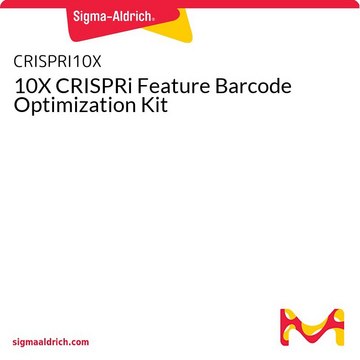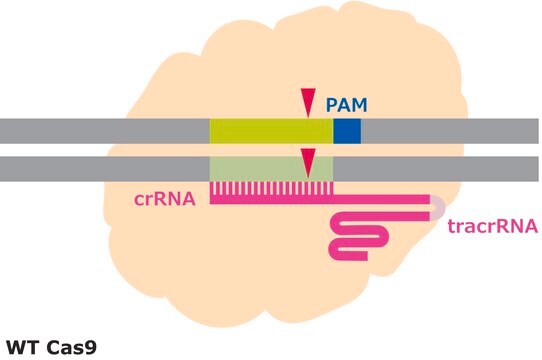推荐产品
重組細胞
expressed in E. coli
品質等級
包裝
vial of 50 μL
濃度
20 ng/μL in TE buffer; DNA (1μg of plasmid DNA)
應用
CRISPR
選擇
kanamycin
運輸包裝
dry ice
儲存溫度
−20°C
一般說明
All-in-one, ready-to-use Cas9 and guide RNA (gRNA) expression plasmids with GUS Reporter
CRISPR Plant Cas9 products are intended for Agrobacterium-mediated plant transformation. The products are based on the type IIA CRISPR-Cas9 derived from Streptococcus pyogenes. The native Cas9 coding sequence is codon optimized for expression in monocots and dicots, respectively. The monocot Cas9 constructs contain a monocot U6 promoter for sgRNA expression, and the dicot Cas9 constructs contain a dicot U6 promoter.
Arabidopsis seedlings were germinated in 6 well tissue culture plates. The seedlings were infected with Agrobacterium which had the CRISPR plasmids with a GUS reporter. After 3-4 days of transfection the GUS expression was detected. b-glucuronidase (GUS) is an enzyme that hydrolyzes colorless glucuronides to yield colored product
CRISPR Plant Cas9 products are intended for Agrobacterium-mediated plant transformation. The products are based on the type IIA CRISPR-Cas9 derived from Streptococcus pyogenes. The native Cas9 coding sequence is codon optimized for expression in monocots and dicots, respectively. The monocot Cas9 constructs contain a monocot U6 promoter for sgRNA expression, and the dicot Cas9 constructs contain a dicot U6 promoter.
Arabidopsis seedlings were germinated in 6 well tissue culture plates. The seedlings were infected with Agrobacterium which had the CRISPR plasmids with a GUS reporter. After 3-4 days of transfection the GUS expression was detected. b-glucuronidase (GUS) is an enzyme that hydrolyzes colorless glucuronides to yield colored product
應用
- To verify successful integration of T-DNA in plant genome
- GUS receptor wheat gGAPDH control for monocots for Agrobacterium mediated transformation
特點和優勢
- Low cost, genome editing option compared to other methods.
- Easy to use
- Online ordering
- Ready to ship in 2 days
成分
1管含50μl的20ng/μl质粒DNA
在不使用时,将试管盖扣紧。
利用无菌实验技术,避免DNAase污染。
在不使用时,将试管盖扣紧。
利用无菌实验技术,避免DNAase污染。
原則
CRISPR/Cas systems are employed by bacteria and archaea as a defense against invading viruses and plasmids. Recently, the type II CRISPR/Cas system from the bacterium Streptococcus pyogenes has been engineered to function in eukaryotic systems using two molecular components: a single Cas9 protein and a non-coding guide RNA (gRNA). The Cas9 endonuclease can be programmed with a single gRNA, directing a DNA double-strand break (DSB) at a desired genomic location. Similar to DSBs induced by zinc finger nucleases (ZFNs), the cell then activates endogenous DNA repair processes, either non-homologous end joining (NHEJ) or homology-directed repair (HDR), to heal the targeted DSB.
其他說明
如需订购的定制的CRISPR植物产品,请访问:CUSTOM ORDERING FORM
儲存類別代碼
12 - Non Combustible Liquids
水污染物質分類(WGK)
WGK 1
閃點(°F)
Not applicable
閃點(°C)
Not applicable
我们的科学家团队拥有各种研究领域经验,包括生命科学、材料科学、化学合成、色谱、分析及许多其他领域.
联系客户支持







